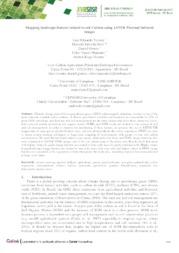Mapping landscape features related to soil carbon using ASTER thermal infrared images.
Mapping landscape features related to soil carbon using ASTER thermal infrared images.
Author(s): VICENTE, L. E.; STOLF, M. T.; LOEBMANN, D. G. dos S. W.; MANZATTO, C. V.; VICENTE, A. K.
Summary: Climatic change derived from greenhouse gases (GHG) anthropogenic emissions consists in one of the main concerns of public policy makers. In Brazil, agricultural activities and livestock are responsible for 23% of gross GHG emissions, and land use and soil management are the main factors that drive these emissions levels. Soil carbon is mainly stocked as soil organic matter (SOM), and SOM stocks are related to clay content in soil and soil management. In order to improve the monitoring of these factors, we propose the use of ASTER TIR images data to map quartz, phyllosilicated clays, and non-photosynthetically active vegetation (NPAV) in order to assess remote sensing techniques to large-scale mapping of environments with greater or less soil carbon accumulation. We used thermal bands ratios to get quartz, phyllosilicated clays, and NPAV image fractions, that were compared to ASTER VNIR images and to the soil classes map of the study area. Results show that areas with higher values in quartz image fraction are related to bare soils areas in quartz-enriched soils. Higher values in phyllosilicates image fraction are related to bare soils areas with clay soils and higher values in NPAV image fraction are consistent to the vegetation activity throughout the study area, including crop residues areas detected in large-scale farms.
Publication year: 2017
Types of publication: Paper in annals and proceedings
Unit: Embrapa Environment
Observation
Some of Embrapa's publications are published as ePub files. To read them, use or download one of the following free software options to your computer or mobile device. Android: Google Play Books; IOS: iBooks; Windows and Linux: Calibre.
Access other publications
Access the Agricultural Research Database (BDPA) to consult Embrapa's full library collection and records.
Visit Embrapa Bookstore to purchase books and other publications sold by Embrapa.

